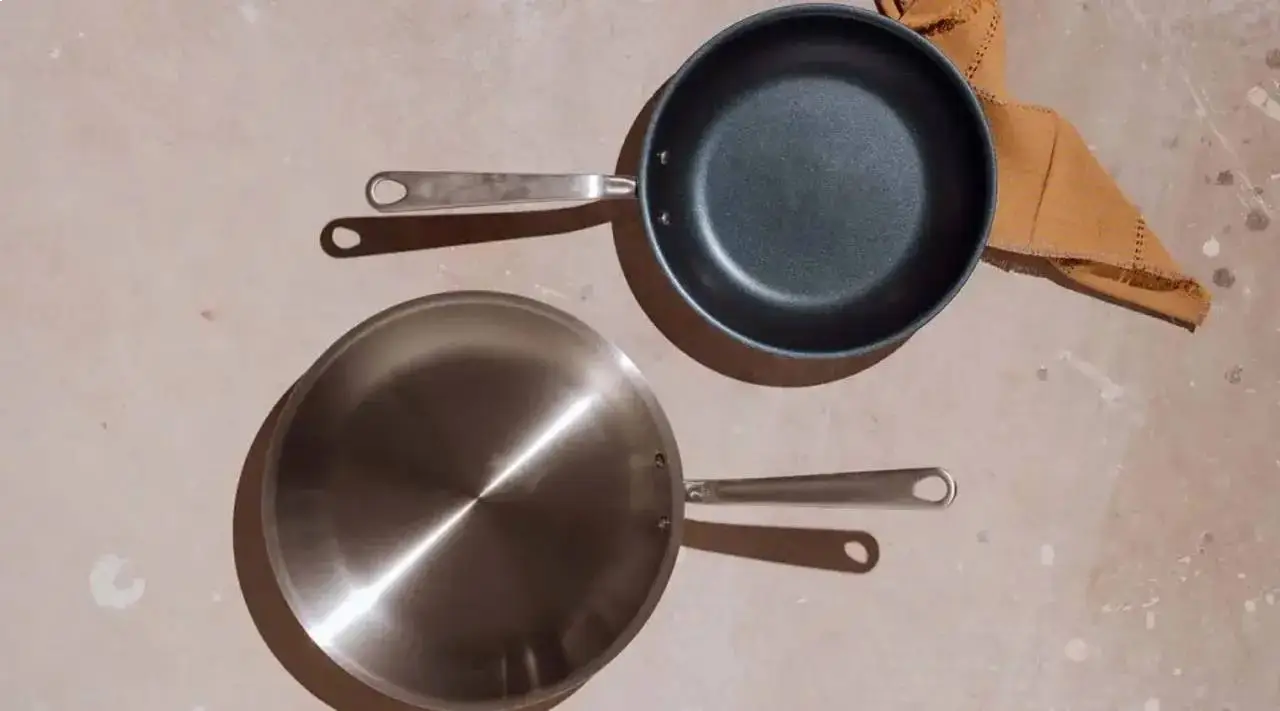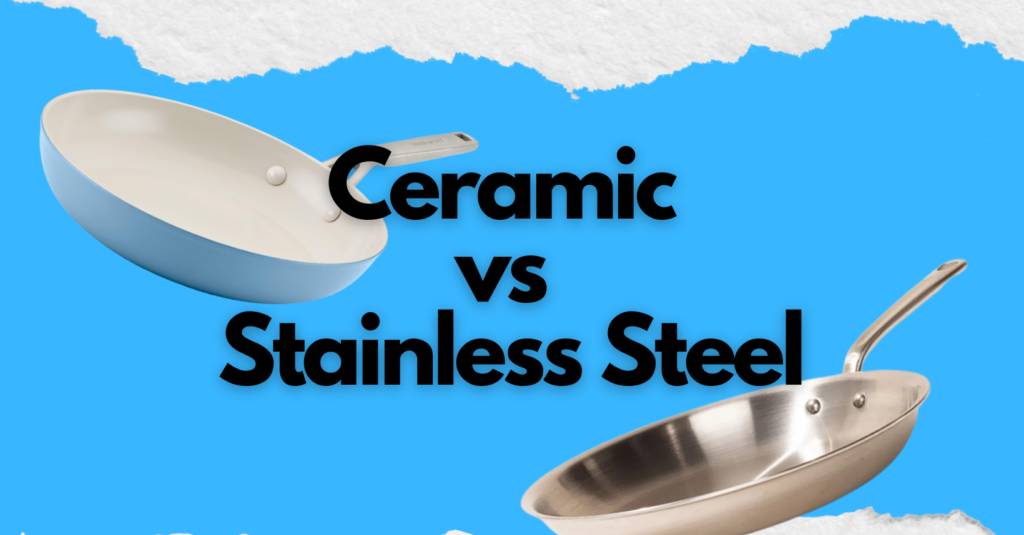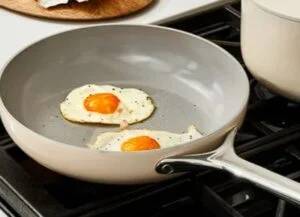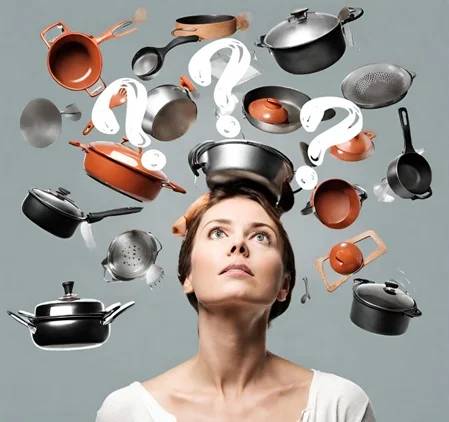• Ceramic
Ceramic Vs Stainless Steel Cookware – The Truth About Both!

Reviewed by Trinity Anderson
Last Updated January 2024

Are you struggling to make a decision between ceramic and stainless steel cookware? Consider this alternative perspective - why not choose both?
Allow me to explain. I believe that different types of cookware have their own unique purposes, depending on the cooking style, the type of stove, and even the individual chef - which, in this case, is you! (more on that later).

However, if you're truly seeking guidance on how to decide between ceramic and stainless steel cookware, and which one is the right choice for you, then this comprehensive guide is exactly what you need.
Which option is superior?
Which one offers greater durability?
Which one is safer to use?
And most importantly, the question that seems to go unanswered:
Which one is the best fit for YOU?
By the end of this article, you will have a clear understanding of the advantages and disadvantages of each option, enabling you to confidently select the cookware that suits your needs.
Let's dive into the comparison between ceramic and stainless steel cookware!
Ceramic vs stainless steel cookware – what’s the difference?
To begin with, it is important to clarify that this article focuses on ceramic coated cookware, not 100% ceramic cookware, which is an entirely different type of cookware.
100% ceramic cookware, such as Xtrema, is crafted without the use of any metals. It is meticulously handmade, glazed, and then baked in a kiln. Many individuals consider it to be the safest option for cookware as it is completely free from any harmful toxins. However, it is crucial to note that in this article, whenever we mention ceramic cookware, we are specifically referring to ceramic coated cookware, not the 100% ceramic variety.
So, what exactly is ceramic coated cookware?
Ceramic coated cookware is essentially metallic cookware, typically made of aluminum but sometimes stainless steel or cast iron, that has been coated with one or more layers of a ceramic-based non-stick coating.

The term "ceramic" technically refers to clay that has been hardened through the process of firing. The composition of the ceramic nonstick coating is essentially similar to that of sand or stone.
Now, you may be wondering how clay or sand can be applied to a metal surface. This is where the "sol-gel" technique comes into play.
The sol-gel process involves converting an inorganic liquid solution into a gel-like substance that can be applied to any metallic object. Sol-gel coatings are typically applied through spraying or by dipping the item into the mineral gel, which is then hardened through a high heat firing process known as curing.
During the curing process, the ingredients in the gel fuse together to create a smooth, glassy surface, which is the characteristic appearance of a ceramic coating.
If the above explanation seemed overwhelming, here's a simplified summary:
Ceramic cookware refers to metallic pans that have been coated with a ceramic nonstick coating. These pans can be made of aluminum, stainless steel, or cast iron.
On the other hand, stainless steel pans are made solely from food-grade stainless steel without any nonstick coating.
Since both types of pans can be made from stainless steel, the primary distinction lies in the fact that one is coated while the other is not.
Ceramic vs stainless steel cookware – Which performs better?
For this question, I’m going to look at 10 criteria objectively, much like I did for my article on ceramic vs teflon.
So here goes:
1. Ceramic vs stainless steel cookware – How high can you heat them?
Ceramic coating can withstand heat up to 842°F, but its nonstick properties may start to deteriorate at temperatures exceeding 662°F. On the other hand, high-quality stainless steel pans have a heat safe range of approximately 500-550°F.
Unlike ceramic, stainless steel does not have a coating and will not melt until it reaches around 1400°F or higher.
However, the heat limit is imposed to prevent warping. Since stainless steel is a poor conductor of heat, most stainless steel cookware incorporates an inner layer of aluminum or copper to enhance heat distribution. Different materials have varying heat tolerances, which become more evident at extremely high temperatures, hence the risk of warping.
In terms of practicality, most cooking is done at medium temperatures ranging from 300-350°F, with searing or baking typically done at 450-500°F. Therefore, there is no need to exceed these temperatures as it may compromise the nutritional value of the food and result in overcooking.
In conclusion, both ceramic and stainless steel cookware exhibit similar heat tolerance.
2. Ceramic vs stainless steel cookware – Which is better for searing food?
To address this inquiry, let's first grasp the concept of searing.
Searing, also referred to as 'the Maillard reaction', occurs when sugars and proteins react to the influence of heat. It results in the delightful caramelization observed on a succulent steak or fish fillet.
Now, here's the key information: the optimal searing temperature ranges from 400°F to 450°F and can go up to 500°F.
Considering that both ceramic and stainless steel cookware can withstand these temperatures, it can be concluded that both options are capable of achieving a satisfactory sear on meat. However, if I were to choose, I would prefer stainless steel. Allow me to explain why.
Although ceramic pans are suitable for high-heat cooking, they are still coated with a nonstick surface that requires delicate handling to prolong its lifespan. Since searing involves intense heat, I avoid using any of my nonstick pans, whether ceramic or Teflon coated.
In conclusion, while both ceramic and stainless steel cookware can deliver a good sear, I would opt for stainless steel as the superior choice.
3. Ceramic vs stainless steel cookware – What’s better for creating a fond and deglazing?
If you are unfamiliar with the term "fond," it refers to the delicious caramelized remnants of food that cling to the bottom of a pan after browning meat or vegetables.
Deglazing, on the other hand, is a culinary method used to remove and dissolve these browned food particles from the pan in order to enhance the flavor of sauces, soups, and gravies. This technique is commonly employed in cooking.
Due to its inherent nature, fond tends to stick to the pan, making it difficult to remove when using a nonstick pan.
In conclusion, when it comes to creating a rich and flavorful fond for deglazing, stainless steel pans are a superior choice.
4. Ceramic vs stainless steel cookware – What’s easier to clean?
To begin with, let me clarify that I always clean pans manually, without any exceptions.
While cookware manufacturers may boast about their products being 'dishwasher safe' (what does that phrase even imply?), I personally do not trust subjecting any cookware to the harsh conditions of a dishwasher.
Now, when it comes to cleaning by hand, which option is more convenient?
In conclusion, ceramic cookware is generally easier to clean due to its nonstick coating.
5. Ceramic vs stainless steel cookware – Which one is easier to maintain?
I'll leave it up to you to figure this one out. One of them requires careful handling, as it can't withstand high heat and is prone to scratching. Additionally, you must avoid using metal utensils with it...
Indeed! Ceramic cookware demands more attention compared to stainless steel. It also has a tendency to stain, which can be quite challenging to remove due to the delicate nonstick coating.
On the other hand, stainless steel cookware doesn't require any special care. If it starts to lose its shine or develops an unsightly rainbow tint, simply using a mixture of vinegar and water or a product like Barkeepers Friend can restore its sparkle.
In conclusion, stainless steel emerges as the winner in terms of low maintenance.
6. Ceramic vs stainless steel cookware – What’s going to last longer?
The nonstick coating on all cookware has a finite lifespan, regardless of your efforts or precautions. Typically, it remains effective for a period of 1-3 years.
However, this does not render the pan completely unusable. It will simply become less nonstick and require additional grease or oil to function properly.
Conversely, stainless steel pans have an exceptionally long lifespan, lasting for several decades.
Conclusion: Ceramic pans have a significantly shorter lifespan compared to stainless steel pans.
7. Ceramic vs stainless steel cookware – Which one is oven safe?
Let's utilize basic information to address this inquiry.
The suggested maximum temperature for ceramic coated cookware is 662 F.
The suggested maximum temperature for stainless steel cookware is 550 F.
For the majority, if not all, recipes, the maximum oven temperature is 500 F.
In conclusion, feel free to use either your ceramic cookware or stainless steel cookware without hesitation when it comes to ovens! Both options are equally secure for regular cooking temperatures.
8. Ceramic vs stainless steel cookware – Which has a shorter learning curve?
At the Cookware Advisor, we have identified the Five Secrets to Cooking with Stainless Steel, which we consider to be a fine art. Unlike nonstick cookware, stainless steel requires some practice to master.
However, with ceramic cookware, even beginner home cooks can easily start cooking without any difficulties. Nevertheless, it is important to remember that basic care principles still apply, such as using wooden or plastic utensils and avoiding heating on an empty pan.
In conclusion, ceramic cookware does not have the same learning curve as stainless steel.
9. Ceramic vs stainless steel cookware –Which one is more versatile?
Stainless steel offers a wide range of possibilities that ceramic cookware simply cannot match. Unlike ceramic, stainless steel allows you to sear without worrying about damaging the nonstick surface.
Additionally, creating a flavorful fond for deglazing, a technique commonly used in gourmet recipes, is difficult to achieve with ceramic. Moreover, even with utmost care, the nonstick coating of ceramic cookware tends to deteriorate within a few years, while stainless steel remains durable and long-lasting.
With stainless steel, you can confidently fry, steam, sauté, boil, braise, sear, deglaze, stew, and poach your culinary creations. Its versatility knows no bounds. Furthermore, stainless steel can withstand rough handling, scratches, and vigorous scrubbing without losing its functionality.
In conclusion, when it comes to versatility, stainless steel surpasses ceramic cookware.
10. Ceramic vs stainless steel cookware – Which one is safer?
Cookware safety is a sensitive subject, and in order to address the ceramic vs stainless steel cookware debate, we must first define what it entails. To do so, let's examine the three main concerns surrounding cookware safety.
Fear #1: Presence of toxic chemicals in food or home
The primary worry here is that traditional nonstick coatings, such as Teflon, which are PTFE-based, can disintegrate when exposed to temperatures nearing 500°F. This can release fumes that are irritating to humans and fatal to birds.
However, this is not the case with ceramic-coated nonstick cookware. The ceramic coating does not disintegrate at high temperatures, eliminating the risk of releasing harmful fumes. Similarly, stainless steel cookware, which lacks any coating, also poses no threat in this regard.
Fear #2: Reactivity of cookware material with food
Ceramic coatings are inert, meaning they do not react with food. This ensures that no unwanted substances are transferred to the food during the cooking process. Likewise, stainless steel is predominantly an inert material that does not react with food.
By addressing these common fears, we can better understand the safety aspects of both ceramic and stainless steel cookware.
Fear #3: Contamination of food with metals.
Extensive research has been conducted on the topic of stainless steel, and you can find the details in this comprehensive study. In essence, stainless steel, which is composed of iron, carbon, nickel, and chromium, does release small quantities of nickel and chromium. However, reputable sources such as whfoods.org and Health Canada assure us that these amounts are negligible and pose no cause for concern.
It is important to note that individuals with a nickel allergy are an exception to this. If you fall into this category, it is advisable to opt for a nickel-free alternative as stainless steel is not suitable for you.
Now, let's address the issue of ceramic coated pans that have been severely scratched, exposing the underlying material. Do they release metals into your food? According to the research I have referenced, the answer is no. Therefore, to summarize:
Even if ceramic coated pans have deep scratches, they will not contaminate your food.
Stainless steel pans do not release significant amounts of nickel or chromium and are generally considered one of the safest options for cookware.
In conclusion, both ceramic cookware and stainless steel cookware are safe choices for your cooking needs.
Ceramic vs stainless steel cookware – which is better for you?
Let's turn the tables on that question. The true question is: which type of cookware suits YOU better when it comes to ceramic versus stainless steel cookware?
Since we have already discussed the safety aspects of ceramic and stainless steel cookware, this question pertains to your cooking style.

If you cook at home, you can either be someone who cooks because they love to or someone who cooks because they have to.
So, what kind of home cook are you?
And how does that relate to ceramic versus stainless steel cookware?
Actually, it has a significant impact!
If you have a "cook because you love to" personality, you might:
1. Be willing to invest in high-quality cookware that will endure for a long time.
2. Be willing to embrace the learning curve that comes with certain cooking materials like stainless steel.
3. Be willing to dedicate time and effort to maintain your cookware and keep it looking pristine. You might even proudly showcase it in your kitchen.
4. Cook recipes that require high-heat searing and/or deglazing of fond.
If you identify as a 'cook because you love to' person, stainless steel cookware is the ideal choice for you. However, if you have more of a 'cook because you have to' personality, nonstick ceramic cookware would be a better option. It's important to note that our cooking personalities are not black and white, but rather a spectrum with shades of both. Considering this, why not have the best of both worlds and choose a combination of ceramic and stainless steel cookware? Ultimately, the decision should be based on your individual cooking habits and preferences. Here are our top recommendations for both ceramic and stainless steel cookware. We hope this helps you make an informed choice between the two.